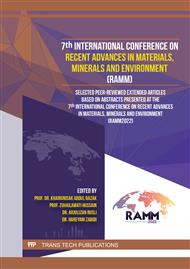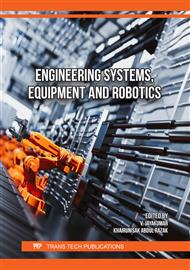[1]
A. Aladdin Sallat, Amit Das, Jana Schaber, Ulrich Scheler and F. B. Eshwaran S. Bhagavatheswaran, Klaus W. Stockelhuber, Gert Heinrich, Brigitte Voit, "RSC Advances rubber †," p.26793–26803, 2018.
DOI: 10.1039/c8ra04631j
Google Scholar
[2]
B. Cheng, X. Lu, J. Zhou, R. Qin, and Y. Yang, "Dual Cross-Linked Self-Healing and Recyclable Epoxidized Natural Rubber Based on Multiple Reversible Effects," ACS Sustain. Chem. Eng., vol. 7, no. 4, p.4443–4455, 2019.
DOI: 10.1021/acssuschemeng.8b06437
Google Scholar
[3]
P. Tanasi, M. Hernández Santana, J. Carretero-González, R. Verdejo, and M. A. López-Manchado, "Thermo-reversible crosslinked natural rubber: A Diels-Alder route for reuse and self-healing properties in elastomers," Polymer (Guildf)., vol. 175, p.15–24, 2019.
DOI: 10.1016/j.polymer.2019.04.059
Google Scholar
[4]
R. Araya-Hermosilla et al., "Thermally reversible rubber-toughened thermoset networks via Diels-Alder chemistry," Eur. Polym. J., vol. 74, p.229–240, 2016, doi: 10.1016/j.eurpolymj. 2015.11.020.
DOI: 10.1016/j.eurpolymj.2015.11.020
Google Scholar
[5]
G. Dhanaraju, S. Golla, B. S. Ben, and K. A. Vikram, "Interfacial and matrix healing of thermally reversible bismaleimide infused Graphene Nano Platelets reinforced polymer nanocomposite through Diels-Alder bonding," Mater. Today Commun., vol. 31, no. January, p.103753, 2022.
DOI: 10.1016/j.mtcomm.2022.103753
Google Scholar
[6]
X. Kuang, G. Liu, X. Dong, and D. Wang, "Enhancement of Mechanical and Self-Healing Performance in Multiwall Carbon Nanotube/Rubber Composites via Diels-Alder Bonding," Macromol. Mater. Eng., vol. 301, no. 5, p.535–541, 2016.
DOI: 10.1002/mame.201500425
Google Scholar
[7]
Y. Chen, Z. Tang, X. Zhang, Y. Liu, S. Wu, and B. Guo, "Covalently Cross-Linked Elastomers with Self-Healing and Malleable Abilities Enabled by Boronic Ester Bonds," ACS Appl. Mater. Interfaces, vol. 10, no. 28, p.24224–24231, 2018.
DOI: 10.1021/acsami.8b09863
Google Scholar
[8]
L. Huang, Y. Yang, Z. Niu, R. Wu, W. Fan, and Q. Dai, "Boronic ester bonds crosslinked vitrimer elastomers with mechanical robustness , shape memory , self-healing and recyclability properties," Compos. Sci. Technol., vol. 228, no. July, p.109621, 2022.
DOI: 10.1016/j.compscitech.2022.109621
Google Scholar
[9]
S. H. Lee, S. R. Shin, and D. S. Lee, "Self-healing of cross-linked PU via dual-dynamic covalent bonds of a Schiff base from cystine and vanillin," Mater. Des., vol. 172, p.107774, 2019.
DOI: 10.1016/j.matdes.2019.107774
Google Scholar
[10]
Z. Gong, J. Huang, L. Cao, C. Xu, and Y. Chen, "Self-healing epoxidized natural rubber with ionic/coordination crosslinks," Mater. Chem. Phys., vol. 285, no. March, p.126063, 2022.
DOI: 10.1016/j.matchemphys.2022.126063
Google Scholar
[11]
Q. Huang et al., "Blending polar rubber with polyurethane to construct self-healing rubber with multiple hydrogen bond networks," Polymer (Guildf)., vol. 246, no. March, p.124768, 2022.
DOI: 10.1016/j.polymer.2022.124768
Google Scholar
[12]
A. M. Grande, J. C. Bijleveld, S. J. Garcia, and S. Van Der Zwaag, "A combinerheological d fracture mechanical e rheological study to separate the contributions of hydrogen bonds and disulphide linkages to the healing of poly ( urea-urethane ) networks," Polymer (Guildf)., vol. 96, p.26–34, 2016.
DOI: 10.1016/j.polymer.2016.05.004
Google Scholar
[13]
A. M. Grande, R. Martin, I. Odriozola, S. van der Zwaag, and S. J. Garcia, "Effect of the polymer structure on the viscoelastic and interfacial healing behaviour of poly(urea-urethane) networks containing aromatic disulphides," Eur. Polym. J., vol. 97, no. October, p.120–128, 2017.
DOI: 10.1016/j.eurpolymj.2017.10.007
Google Scholar
[14]
L. Yang, M. Wu, X. Yang, B. Lin, L. Fu, and C. Xu, "Healable, recyclable, and adhesive rubber composites equipped with ester linkages, zinc ionic bonds, and hydrogen bonds," Compos. Part A Appl. Sci. Manuf., vol. 155, no. January, p.106816, 2022, doi: 10.1016/j.compositesa. 2022.106816.
DOI: 10.1016/j.compositesa.2022.106816
Google Scholar
[15]
Z. Jia, S. Zhu, Y. Chen, W. Zhang, B. Zhong, and D. Jia, "Recyclable and self-healing rubber composites based on thermorevesible dynamic covalent bonding," Compos. Part A Appl. Sci. Manuf., vol. 129, no. September 2019, p.105709, 2020, doi: 10.1016/j.compositesa. 2019.105709.
DOI: 10.1016/j.compositesa.2019.105709
Google Scholar
[16]
J. Nie, W. Mou, J. Ding, and Y. Chen, "Bio-based epoxidized natural rubber/chitin nanocrystals composites: Self-healing and enhanced mechanical properties," Compos. Part B Eng., vol. 172, no. April, p.152–160, 2019.
DOI: 10.1016/j.compositesb.2019.04.035
Google Scholar
[17]
C. G. Robertson and N. J. Hardman, "Nature of carbon black reinforcement of rubber: Perspective on the original polymer nanocomposite," Polymers (Basel)., vol. 13, no. 4, p.1–28, 2021.
DOI: 10.3390/polym13040538
Google Scholar
[18]
V.C. Chandrasekaran, "Rubbers and Their Relevant Properties for the Chemical and Mineral Processing Industries," Rubber as a Constr. Mater. Corros. Prot. A Compr. Guid. Process Equip. Des., p.79–107, 2010.
Google Scholar
[19]
A. Kato, Y. Ikeda, and S. Kohjiya, "Reinforcement Mechanism of Carbon Black (CB) in Natural Rubber Vulcanizates: Relationship Between CB Aggregate and Network Structure and Viscoelastic Properties," Polym. - Plast. Technol. Eng., vol. 57, no. 14, p.1418–1429, 2018.
DOI: 10.1080/03602559.2017.1381257
Google Scholar
[20]
N. Laila, N. Thajudin, M. H. Zainol, and R. K. Shuib, "Intrinsic room temperature self-healing natural rubber based on metal thiolate ionic network," Polym. Test., vol. 93, p.106975, 2021.
DOI: 10.1016/j.polymertesting.2020.106975
Google Scholar
[21]
S. R. Khimi, S. N. Syamsinar, and T. N. L. Najwa, "ScienceDirect Effect of Carbon Black on Self-healing Efficiency of Natural Rubber," Mater. Today Proc., vol. 17, p.1064–1071, 2019.
DOI: 10.1016/j.matpr.2019.06.513
Google Scholar
[22]
S. H. Song, "Study on silica-based rubber composites with epoxidized natural rubber and solution styrene butadiene rubber," Polym. Polym. Compos., vol. 29, no. 9, p.1422–1429, 2021.
DOI: 10.1177/0967391120971391
Google Scholar
[23]
S. Sattayanurak et al., "Synergistic effect by high specific surface area carbon black as secondary filler in silica reinforced natural rubber tire tread compounds," Polym. Test., vol. 81, no. October 2019, p.106173, 2020.
DOI: 10.1016/j.polymertesting.2019.106173
Google Scholar
[24]
Y. Chen, J. Nie, C. Xu, W. Wu, and Z. Zheng, "Strengthened, Recyclable, Weldable, and Conducting-Controllable Biobased Rubber Film with a Continuous Water-Soluble Framework Network," ACS Sustain. Chem. Eng., vol. 8, no. 2, p.1285–1294, 2020.
DOI: 10.1021/acssuschemeng.9b06644
Google Scholar
[25]
S. van der Marianella Hernández, M. Mar Bernal, Antonio M. Grande, Nan Zhong and Z. and S. J. García, "Effect of Graphene Content on the Restoration of Mechanical, Electrical and Thermal Functionalities of a Self-Healing Natural Rubber," Smart Mater. Struct., vol. 26, no. 8, 2017.
DOI: 10.1088/1361-665x/aa71f5
Google Scholar
[26]
P. Niu et al., "Room-temperature self-healing elastomer-graphene composite conducting wires with superior strength for stretchable electronics," Compos. Sci. Technol., vol. 219, no. December 2021, p.109261, 2022.
DOI: 10.1016/j.compscitech.2022.109261
Google Scholar
[27]
M. H. Zainol, M. F. O. Zulkifli Mohamad Ariff, T. M. Ping, and Raa Khimi Shuib, "Self-healable and recyclable nitrile rubber based on thermoreversible ionic crosslink network," J. Appl. Polym. Sci., vol. 139, no. 15, 2021.
DOI: 10.1002/app.51948
Google Scholar
[28]
C. Gong et al., "A facile strategy for high mechanical performance and recyclable EPDM rubber enabled by exchangeable ion crosslinking," Eur. Polym. J., vol. 175, no. May, p.111339, 2022.
DOI: 10.1016/j.eurpolymj.2022.111339
Google Scholar
[29]
Azemi Samsuri, Tear Strength of Natural Rubber. Latvia, European Union: LAP LAMBERT Academic Publishing, 2018.
Google Scholar
[30]
M. Farooq, A. Ansarifar, and X. Bao, "A study into crack initiation and growth in peroxide-cured silica-filled polybutadiene rubber vulcanisate under a cyclic loading condition," J. Rubber Res., vol. 24, no. 1, p.69–75, 2021.
DOI: 10.1007/s42464-020-00074-4
Google Scholar



